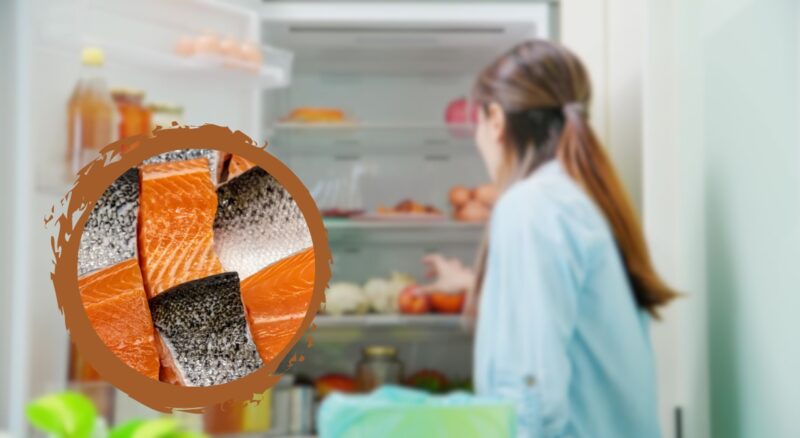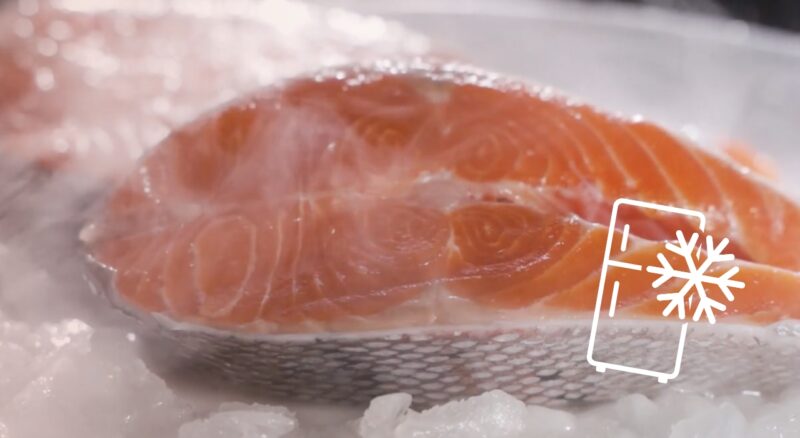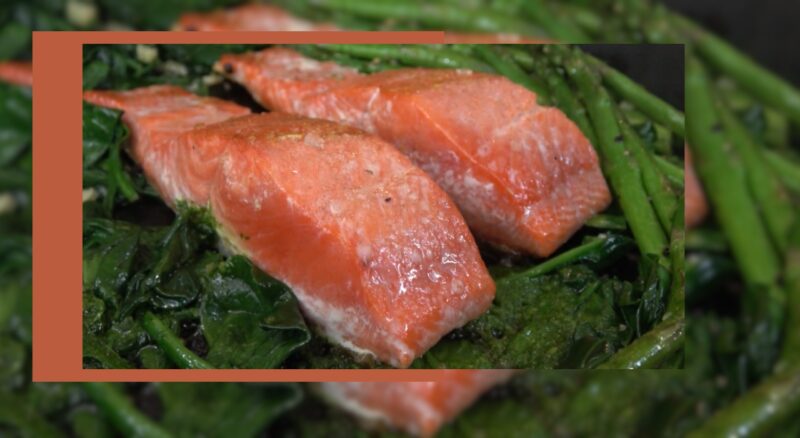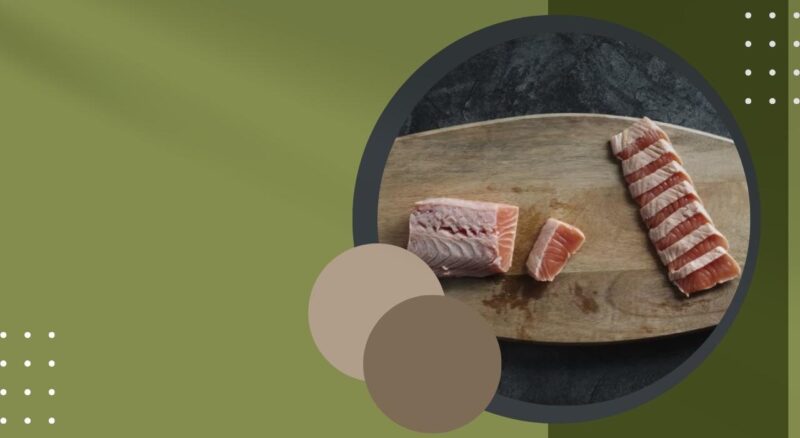Salmon, a popular and nutritious seafood, is a favorite choice for many of us due to its rich flavor, versatility, and numerous health benefits. Oh God, and the color! I love the color of it, and I’m not even a huge fish fan. Grilled, baked, or pan-seared, this fish makes for a delicious and satisfying meal. However, a common question is: how long can cooked salmon be refrigerated?
The answer to this question is crucial as it directly impacts food safety and quality. Improper storage or extended refrigeration can lead to spoilage, which not only compromises the taste and texture of the salmon but can also pose health risks.
Refrigeration Timeline

As a general guideline, cooked salmon can be safely refrigerated for up to three days. This timeline assumes that the salmon has been properly stored. However, its actual shelf life can be influenced by several factors. These include the freshness of the salmon before it was cooked, the cooking method used, and the specific storage conditions.
For instance, salmon that was very fresh before cooking and stored properly may last longer than three days in the refrigerator. It’s important to note that while refrigeration slows down the growth of bacteria, it doesn’t stop it completely. Therefore, even properly stored fish will eventually spoil.
In the following sections, we’ll discuss how to identify signs of spoilage and what you can do to extend the shelf life of cooked salmon.
Factors to consider…
Salmon is highly valued for its nutritional content. It’s packed with high-quality protein, essential omega-3 fatty acids, and a variety of vitamins and minerals, including B vitamins, potassium, and selenium. Regular consumption of salmon can contribute to heart health, brain function, and overall well-being.
The shelf life of cooked salmon, like any other food, is influenced by several factors. These include the freshness of the salmon before cooking, the cooking method used, and how it’s stored after cooking. Proper handling at each stage is crucial to maximize its shelf life and maintain its quality.
Understanding the factors that affect this can help you make informed decisions about its storage. For instance, salmon cooked with acidic ingredients like lemon or vinegar may have a slightly shorter shelf life due to the acid’s effect on the fish’s protein structure.
Proper Storage

The key to extending the shelf life of the fish is immediate refrigeration. Once the salmon has cooled to near room temperature, it should be promptly refrigerated to slow down the growth of bacteria and other microorganisms that can lead to spoilage.
Leaving cooked salmon at room temperature for more than two hours can significantly increase the risk of foodborne illness. The temperature at which cooked salmon is stored is also crucial. The USDA recommends storing it at a temperature below 40°F (4°C).
At this temperature, the growth of bacteria is significantly slowed, helping to preserve the salmon’s quality and safety for consumption. When storing cooked salmon, it’s also important to use airtight containers.
This not only prevents the salmon from drying out but also protects it from absorbing odors from other foods in the refrigerator. If airtight containers are not available, wrapping the salmon tightly in aluminum foil or plastic wrap can also be effective.
Signs of Spoilage
Identifying signs of spoilage is crucial to ensure food safety. One of the most obvious indicators of spoiled salmon is a foul or off-putting smell. Freshly cooked salmon has a mild, delicate aroma, so any strong, fishy, or sour smell is a clear sign that the salmon has spoiled and should not be consumed.
Changes in color and texture can also indicate spoilage. The fish should be moist and flaky, with a uniform pink or orange color. If the salmon appears dry, discolored, or slimy, it’s likely spoiled and should be discarded. Another sign of spoilage is the presence of mold.
Any visible mold on the surface of the salmon is a clear indication that it’s spoiled. In all cases, if there’s any doubt about the freshness of the salmon, it’s best to err on the side of caution and discard it.
How to extend the Shelf Life?

Proper packaging and storage techniques can significantly extend the shelf life of cooked salmon.
As mentioned earlier, storing the salmon in an airtight container or wrapping it tightly in aluminum foil or plastic wrap can help maintain its quality in the refrigerator. It’s also important to refrigerate the salmon promptly after it has cooled to near room temperature. For longer preservation, freezing is an excellent option.
Cooked salmon can be safely frozen for up to six months without significant loss of quality. To freeze it, let it cool to near room temperature, then wrap it tightly in aluminum foil or plastic wrap, and place it in a freezer-safe bag or container.
Be sure to squeeze out as much air as possible before sealing the bag or container to prevent freezer burn. When you’re ready to eat the frozen salmon, thaw it in the refrigerator overnight. It’s important to note that once the salmon has been thawed, it should be eaten within two days and should not be refrozen.
Health and Safety Considerations
Consuming spoiled or improperly stored salmon can lead to foodborne illness, with symptoms ranging from mild discomfort to severe dehydration and hospitalization. Therefore, it’s essential to follow proper storage guidelines and to always check for signs of spoilage before consuming refrigerated or frozen cooked salmon.
The risks associated with consuming spoiled salmon underscore the importance of proper storage. If you’re unsure whether the salmon is still good, it’s best to err on the side of caution and discard it. In addition to these safety considerations, it’s also important to consider the impact of storage on the quality of the salmon.
Over time, even properly stored salmon can lose its flavor and texture. Therefore, for the best taste and quality, it’s recommended to consume the fish within a few days of cooking.
Storage Tips for Leftovers
Leftover fish can make for a quick and nutritious meal, but it’s important to store it properly to maintain its quality. As with freshly cooked salmon, leftovers should be refrigerated promptly after they have cooled to near room temperature. When storing leftovers, it’s best to use airtight containers.
These not only protect the salmon from drying out but also prevent it from absorbing odors from other foods in the refrigerator. If airtight containers are not available, wrapping the salmon tightly in aluminum foil or plastic wrap can also be effective.
It’s also a good idea to portion out the leftovers before refrigerating them. This allows you to take out only what you need for each meal, minimizing the number of times the salmon is reheated and reducing the risk of spoilage.
Reheating
Reheating cooked salmon requires some care to ensure it doesn’t dry out or overcook. The best method for reheating depends on the size and thickness of the salmon. For smaller, thinner pieces, microwaving on a low power setting can work well. For larger, thicker pieces, reheating in the oven at a low temperature is a better option.
When reheating the fish, it’s important to heat it to an internal temperature of at least 145°F (63°C) to ensure food safety. However, be careful not to overheat the salmon, as this can make it dry and tough. Adding a splash of water, broth, or wine before reheating can help keep the salmon moist.
After reheating, let the salmon rest for a few minutes before eating. This allows the heat to distribute evenly, ensuring the salmon is warmed throughout.
When to Discard It?
As a general guideline, cooked salmon should be eaten within three days of refrigeration. However, if it shows any signs of spoilage, such as a foul smell, changes in color or texture, or visible mold, it should be discarded immediately.
It’s important to remember that even if the fish doesn’t show obvious signs of spoilage, it can still harbor bacteria that can lead to foodborne illness. Therefore, it’s always best to err on the side of caution and discard the salmon if you’re unsure about its freshness.
Responsible food handling is key to preventing foodborne illness. Always wash your hands before and after handling the fish, and clean all utensils and surfaces that come into contact with the salmon.
Cooked Salmon in Recipes and Meals

Refrigerated cooked salmon can be a versatile ingredient in a variety of dishes. From salads and pastas to wraps and stir-fries, there are countless ways to incorporate this fish into your meals. Not only does this add a boost of protein and omega-3 fatty acids to your dishes, but it also adds a delicious flavor.
One simple and nutritious way to use it is in a salad. Flake the salmon and toss it with mixed greens, cherry tomatoes, cucumber, and your favorite dressing for a quick and healthy meal. The combination of tender salmon and crisp vegetables creates a refreshing and satisfying dish.
You can also add cooked salmon to pasta dishes to elevate their taste and nutritional value. Simply flake the refrigerated salmon and mix it into your favorite pasta sauce. Whether it’s a creamy Alfredo, a zesty tomato-based sauce, or a light olive oil and garlic combination, the addition of salmon adds a delightful richness and complexity to the pasta.
Another idea is to stir the fish into scrambled eggs for a protein-packed breakfast or brunch option. The creamy texture of the salmon complements the fluffy eggs, creating a savory and filling dish. Add some herbs, such as dill or chives, to enhance the flavor further.
If you’re looking for a unique and flavorful meal, consider using refrigerated cooked salmon as a topping for a baked potato. Simply scoop out the flesh of a baked potato, flake the salmon, and mix it with some sour cream, chopped green onions, and a sprinkle of lemon zest.
Fill the potato skin with this delicious mixture and bake it until heated through. The combination of the creamy potato, tangy sour cream, and delicate salmon creates a satisfying and indulgent meal. For a more creative option, try making salmon cakes.
Combine flaked cooked salmon with breadcrumbs, eggs, and your favorite herbs and spices, such as parsley, dill, and paprika. Form the mixture into patties and pan-fry them until golden brown. Serve these flavorful salmon cakes with a side of mixed vegetables or a fresh salad for a complete and well-balanced meal.
FAQs:
Can I eat cooked salmon that has been refrigerated for a week if it looks and smells fine?
It is generally recommended to consume it within 3-4 days of refrigeration to ensure its safety and quality. It’s best to err on the side of caution and discard it if it has been refrigerated for a week.
Can I store the fish at the front of the refrigerator rather than the back?
It is advisable to store cooked salmon in the coldest part of the refrigerator, usually the back, to maintain its freshness for a longer period.
Can I refrigerate the fish in its original packaging from the store?
It is best to transfer it to an airtight container or wrap it tightly before refrigerating to maintain its freshness and prevent any potential contamination.
Is it safe to eat the fish that has been left out overnight?
No, it is not safe to consume cooked salmon that has been left out at room temperature for more than 2 hours.
Can I refrigerate leftovers that have been seasoned with citrus or acidic ingredients?
Seasoned fish can be refrigerated, but the acidic ingredients may affect the texture and quality over time. Consume it within the recommended storage time for the ingredients used.
Final thoughts
In conclusion, cooked salmon is a nutritious and versatile food that can be safely refrigerated for up to three days, provided it’s stored properly. While refrigeration can extend the shelf life of the fish, it’s important to be aware of the signs of spoilage, including a foul smell, changes in color or texture, and visible mold.
If the salmon shows any of these signs, or if you’re unsure about its freshness, it’s best to discard it. For longer preservation, freezing is an excellent option. Cooked salmon can be safely frozen for up to six months without significant loss of quality.
However, once the salmon has been thawed, it should be eaten within two days and should not be refrozen. In the end, the key to safely refrigerating the fish lies in proper storage and handling practices, as well as a keen awareness of the signs of spoilage. Bon appetit!

